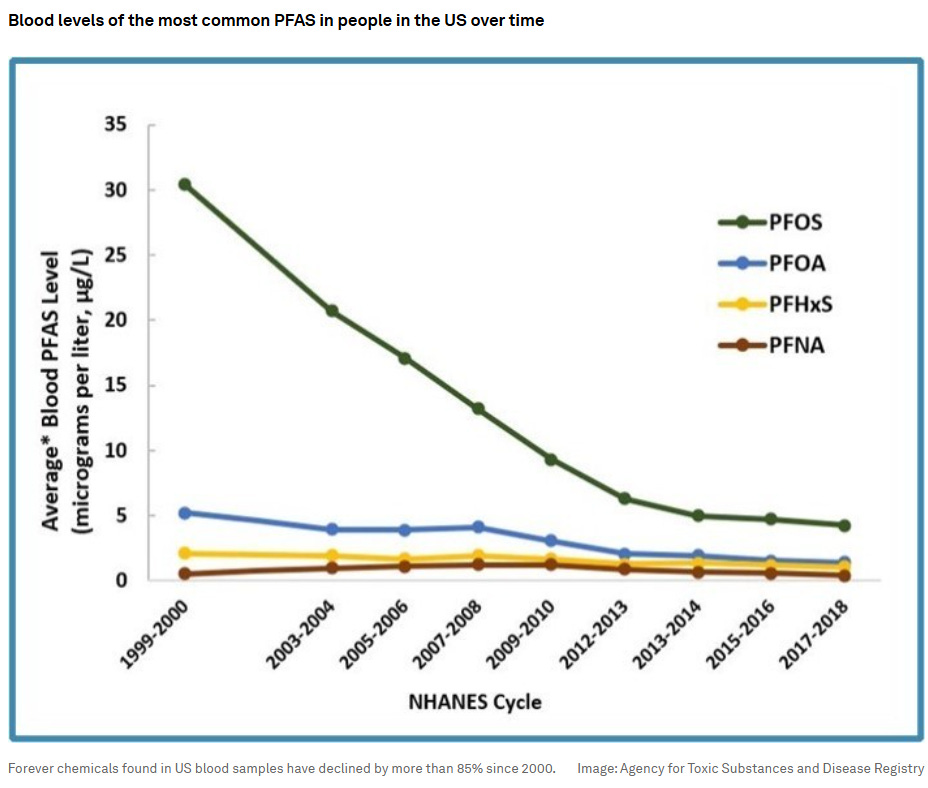IQ is declining. The hereditarian explanation for a decline in IQ is dysgenics, mutational load, or mass immigration. My intention is not to disprove these possibilities, but to provide positive evidence for the idea that “forever chemicals” (among other things) are making us dumb.
If certain industrial processes require the production of “forever chemicals,” then a rising global population will necessitate greater levels of these chemicals per square mile, which will continue to make us dumber. Since dumber societies tend to be more violent, anyone who seeks to prevent violence should be skeptical of natalists and be open to alternatives.
This study from 2018 strongly rejects the idea that declining IQ is only hereditary. Instead, declining IQ is attributed to environmental factors, such as “changes in educational exposure or quality, changing media exposure, worsening nutrition or health, and social spillovers from increased immigration.”
By “social spillover,” the implication is that spending time around immigrants lowers the IQ of natives, either due to increased stress (which inhibits cognitive development) or due to cultural reverse-assimilation (white-to-black trans-racialism).
By worsening education, this could mean a decline in both the quality of K-12 education as well as a decline in the quality of college education.
Finally, a decline in health could be related to obesity and dietary deficiencies, or it could be related to the net increase in “forever chemicals” and their effect on cognitive development.1
In the 2018 study on declining cognitive ability, measured by birth cohort, the most recent cohort is 1990 because people born more recently have not yet been studied as extensively. But there is evidence that between 1960 and 1990, and extreme amount of “forever chemicals” were added to the environment.
National trends in drinking water quality violations (2018) shows a clear spike in PFAS violations detected between 2000 and 2005. The problem with this data is that it shows detections, not necessarily the actual previous historical levels. Studies on PFAS, and the means to detect them, increased significantly in the previous decade.
Drinking water pollution probably reached its all-time high in 1999. Since then, scientists and regulators have worked together to reduce the levels of pollution in drinking water.
One of the problems with measuring the effects of PFAS on cognitive ability is that these studies must be longitudinal. For example, if PFAS does not affect adults, but affects children, then in order to measure the full scale of the affect one must measure the expected cognitive ability and compare this with the resultant cognitive ability, controlling for all other variables. This is difficult, especially when the effect is small enough to be disguised by other cofounders, as in the case of a 5 IQ point drop.
But a 5 IQ point drop is significant enough to have serious economic, political, and social implications. While there is already an established relationship between PFAS and cognitive deficiency, my argument is that the government’s supposed “acceptable level” of PFAS is based on insufficient data, and the true “acceptable level” might be much lower than that set by the government.
If this is the case, then even if PFAS is lower today than a decade ago, it might still be above the threshold of effect, and still have a negative effect on cognitive development.
conclusion.
Corporations have a vested interest in fighting environmental regulation. Regulation is expensive and it hurts businesses. If a chemical were harmless, and it were regulated, this would be a loss for society with no benefit.
However, the true costs are rarely ever calculated. Usually, when regulators assess the cost of chemical damage, they are assessing things like cancer, heart disease, lung disease, and other physical and obvious deficiencies. They are not calculating the potential economic loss of small or subtle declines in IQ (5 points) over a working-age population of 163 million people.
Let’s assume that a decline of 1 IQ point in an individual leads to a loss of $1,000 over a lifetime. Now let’s assume there’s a chemical in the water which causes this 1 IQ point loss in all 163 million working Americans. The result would be a loss of $163 billion over a projected 40 years of labor, or approximately $4.1 billion per year.
The problem with this estimate, however, is that the relationship between IQ and income isn’t $1,000 per IQ point over a lifetime, but $1,000 per IQ point per year. Therefore, a loss of 1 IQ in the total working population would be equivalent to the loss of $163 billion every single year.
Out of a net revenue of all chemical companies of $5.7 trillion, this would mean that the total loss represents 2.9% of all chemical revenue, which would justify a Pigouvian tax of 2.9% on these companies. However, if the IQ loss is 5 points (still small enough to be difficult to detect), then the total yearly loss would be $815 billion, and would justify a Pigouvian tax of 14.3%. Of course, not all chemical companies produce PFAS, so the targeted tax would be much higher and more specific to the particular chemicals described here.2

For reference, the largest chemical company in America has a net revenue of only $43 billion. Just on the basis of declining intelligence alone, it would be worth it to increase tremendous fines and regulations on chemical companies for releasing PFAS and other pollutants into the environment, until we can figure out what the hell is going on.
When national IQ is clearly declining, and there is a relationship between declining IQ and pollution, it is irresponsible to take a permissive attitude. The burden of proof lies upon the chemical companies. Until they can prove that their pollution produces no cognitive decline, regulators must take steps to protect America’s collective biological property.
2025, Effects of Early-life PFAS Exposure on Child Neurodevelopment: A Review of the Evidence and Research gaps: https://pmc.ncbi.nlm.nih.gov/articles/PMC11785707/
This doesn’t factor in other health costs, like cancer, infertility, sexual health, hormonal health, psychological health, general increased mortality, or decreased athleticism and quality of life. We’re just talking about IQ. When everything else is factored in, tax rates could get extraordinarily high, exceeding 100% in some cases.








They are turning the frigging frogs gay too
If pollution is a significant cause of IQ decline, you would expect to see the worst results where pollution builds up, in the largest tributaries and outflows of major rivers. These cover several urban centers which claim to be unaffected.
Pollutants and toxins do seem bad on their own. I have significant doubts that the damage they do compares in scale to dysgenic mating patterns.